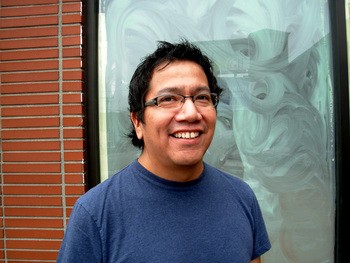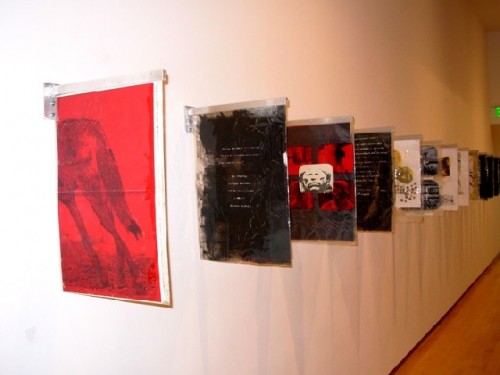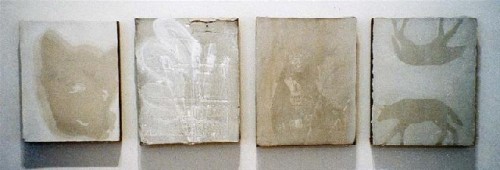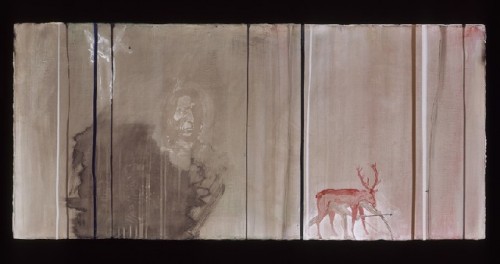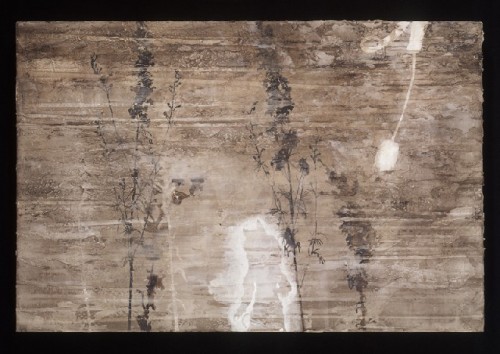Studio Visit with Duane Slick
RISD Faculty Member
By: Charles Giuliano - Sep 22, 2013
In 1992 performance artist, James Luna, chaired a panel at the College Art Association titled “Everyone Needs an Indian.” The distinguished panelists included Jaune Quick-To-See Smith, Frank Lapena, and Rick Hill. The topic explored responses to the 500th anniversary of Columbus and issues of Native identity. “The very first question from the audience,” recounted Duane Slick, a professor of painting at the Rhode Island School of Design as we met for several hours in his 2,500 square foot loft studio, “was ‘How has the Native American community responded to the phenomenon of crop circles?’ ” He discussed how with exasperation the panelists each struggled to deal with the surreal absurdity of such a non sequitur particularly following such intense and serious presentations regarding the pending national celebration of the legacy of Columbus and the ironic “discovery” of the New World by Europeans.
This event and its absurd audience response “crop circles” has became a part of his “The Coyote Papers: Instructions on the Care and Use of White Space: A Coyote Primer for the Next Major Columbus Discovery.” It was his contribution to a 2003 CAA panel “Native American Artists/ Scholars: Speaking for Ourselves in the Twenty First Century.” The session was chaired by Phoebe Parris including Slick as well as Gail Trembley, Edgar Heap of Birds, and XXX. In the paper he referred to the “Crop Circle” event and its significance and how that motivated him to reconsider a number of the issues and positions of 1992, a year of Columbus events and activities, and to measure progress and change since then. As a member of the calendar committee at RISD he fought for removal of Columbus Day as an official school holiday.
Our dialogue included references to the importance of the Coyote or Trickster in native mythology. Just how did that play out and what was its role and function? Was Slick the trickster in the veiled and complex manner in which he evasively answered questions? He discussed his role as a “spy” living in the two worlds of native culture and mainstream white America. How does one transition back and forth? What can be conveyed to a non Native researcher, an individual who may convey misinformation or reveal tribal secrets.
Part of the “trickster” responses and analogies that Slick offered seemed to probe where I was coming from in pursuing this ever more daunting and complex research project. Was I yet another “new ager” harboring romantic notions of native people? He obliquely mentioned a not very successful meeting with a non native researcher of a book project just the week before. It was a reference to those who view Native Americans as a source for the shamanistic truth. I assured him that I was pursuing encounters with strong work and challenging issues.
I asked Slick what we might talk about? If the roles were reversed just what questions would he ask? What should a person exploring Native American art and culture need to know? Just what are the good, tough, relevant questions? Part of the problem is that so little has been done in this field by non natives. Accordingly the dialogue is not very refined. In fields such as anthropology, sociology, history and archeology there has been conflict and soul searching. So research agendas are now rather well defined, and even restricted, by interactions between white scholars and tribal groups. Natives have had greater impact and influence about what is published about them. This is a topic that was written about with brilliant wit and insight by Vine Victor Deloria, Jr. (March 26, 1933 – November 13, 2005)
Quoting from Slick’s “The Coyote Papers” he states that “…It was Anthropologist Beatrice Medicine from the Lakota Nation who identified three issues. 1. The issues of communal or tribal identity in relation to the mainstream whose primary value is the individual. 2. The issue of tribal ethics and values vs. market ethics and values. 3. The issue of the sacred and the secular or the issues of function; the cultural function of tribal objects, signs, images, symbols or other intellectual property in a capitalist society.”
Because there were “no jobs on the reservation in the 1950s” his father left and got a job with the John Deere company, in Waterloo, Iowa working in the foundry. Duane grew up as one of seven children and went to school with few if any native classmates. They would travel to visit family in his father’s Sauk and Fox nation in Iowa and his mother’s family among the Winnebago nation of Nebraska. Returning from these trips the parents would say “When you go to school tomorrow don’t talk about what you’ve seen because the white man doesn’t understand and the first thing he will try to take it away. So we grew up with that.”
This meant not revealing tribal secrets and ceremonies. For Slick, who “drew avidly as a kid” the “loophole” is art. While restricted from speaking or telling he could convey his thoughts and experiences through images. I asked if his talent and commitment drew favorable interest and encouragement from high school art teachers. The surprising answer was “not really, there were always lowered expectations.” The talent and ability to draw was always there. During a time of transition at a community college he took foundation art classes which “bored me” but a related humanities class and its challenging readings was key to his commitment to study art. It was the ideas that always interested him more than craft and technique.
Since he runs the graduate painting program at RISD (ten students accepted each year from a field of about 380) I asked to what extent that entailed theory and philosophy? His answer was on the line of “don’t throw me into that briar patch.” That it was a weapon that “would be used against me” so it became one that he could use. Which is in sync with other graduate programs.
In the area of painting, RISD is regarded as second only to Yale. That theorist aspect became evident when we discussed the work in the studio. A group of small paintings were about to be sent to a show at Albert Merola Gallery in Provincetown (he was a fellow there for two years at the Fine Arts Work Center). Another body of work was shipped to the Aldrich Museum of Art in Connecticut for the show curated by Richard Klein No Reservations: Native American History and Contemporary Art. He showed this past season at Nina Nielsen Gallery in Boston.
Wondering about those ceremonies that his parents warned the kids not to talk about I asked if he were Christian? He responded that he is a member of the Native American Church. “Oh, peyote,” I responded. “Yes we are Christians but for obvious reasons I can’t talk about it.”
What follows is a Google search.
"The Native American Church, which today has some 250, 000 members among numerous tribes, was founded in 1918. Especially important was Quanah Parker, a Comanche chief who is said to have first taken peyote in Mexico in the 1880s as medicine for a difficult illness, or perhaps a serious injury. Quanah (as he is usually referred to), whose mother was white and who was a leading advocate of white-Indian cooperation, became a leading advocate of peyote and was instrumental in turning back laws that would have forbidden its use. By the time of his death in 1911, peyote was being used by several tribes in Oklahoma. Second only to Quanah in influence was John Wilson, a Caddo Indian by affiliation (actually of mixed Caddo, Delaware, and French blood). In 1880 Wilson became a peyote roadman, as the ceremonial leader is known, and began to attract a substantial following. His version of the Peyote ceremony had more explicitly Christian elements than Quanah’s, reflecting, probably, Wilson’s own Catholicism. However, both versions reflect a thorough mixing of traditional Indian and Christian themes.
“Gradually the ceremonial use of peyote spread to other tribes. Several missionaries for the new faith carried its message to tribes who had not yet heard of it. Although sometimes routine contact between tribes living in proximity led to the dissemination of peyotism, one key agent of the dispersal was the existence of institutions that served multiple tribes. The Carlisle Indian School at Carlisle, Pennsylvania, was a major point of intertribal contact, as was the Haskell Institute (now known as Haskell Indian Nations University) in Lawrence, Kansas. Indians from peyote-using areas taught the peyote way to their peers from other parts of the United States, and in relatively short order the new religion reached much of Indian America.”
Slick earned a B.F.A. and a B.A. in art education from the University of Northern Iowa in 1986. At the University of California, Davis he earned a M.F.A. degree. He began teaching full time at the Institute of American Indian Arts in Santa Fe a school that is chartered and funded by Congress. During his time there in the early 90’s the school was flourishing with 250 students from 90 tribes. This was a lively and diverse student body that included full blood, mixed, African-Native, as well as a gay and lesbian sub group. But he speaks better of the students than the faculty. He got out and was recruited by RISD just when the school had its funding slashed by Newt Gingrich.
At RISD he was initially asked to join a committee on cultural diversity but he refused preferring to be regarded as an artist than a statistic. “I didn’t participate because their tuition level automatically excluded too many people.” Eventually he chaired the painting department for two years before taking over as coordinator of graduate studies in painting. This past year he became a full professor. So he has accomplished a lot for a relatively young artist (born 1961).
To what extent is he a role model? Has he been able to use his influence to recruit talented young Natives to RISD. Not really is the answer. The issue is not admission but retention as there is a limited native community for a young person to interact with and RISD does not have deep pockets. Graduate school costs $30,000 a year and there is little scholarship assistance. By contrast, Brown University, a neighbor in Providence, “Has a Native American club for undergraduates.” Could they cross register at RISD and is that a way to recruit I asked? But it is apparently too complex. He noted how RISD undergraduates tend to be the children or privilege but this is not true of the graduate students who are making an enormous commitment and investment in their future. But Slick says that they get a lot for their money in a small and intimate program with a great student to faculty ratio of contact compared to “diploma factories” offering a M.F.A. degree.
He is currently a member of the Board of the College Art Association. From this vantage point he serves as a Coyote/ Spy in observations on the differences between those living on reservations and individuals in the East who are rediscovering their identity. Attending a conference in which young scholars of native studies presented papers he found a great difference in the nature of topics presented by Rez and Non Rez speakers.
To illustrate his point he recounted an experience as a young visiting artist in Fort Wayne, Indiana. There were two quite different bands of Indians and he described being “abducted” on separate occasions by both groups, Rez and non. “They hated each other,” he said. “One group called themselves the Traditionals and they referred to the others as the New Agers. The Traditionals were full blood and lived as an extended family. The New Agers were middle aged and had discovered that they were a quarter to an eighth native. They were not interrelated. We came to their houses in the suburbs it was a nice neighborhood with swimming pools and BMWs in the driveway. There were all the trappings of white entitlement. Their homes were filled with all kinds of Indian patterned decorations which you get at Walmart. Tourist curios. They had reached a point in their life where they were looking for something more and seeking shamans and spiritual teachers to show them rituals. I found it very sad.”
Given the communal strictures just how did the work evolve and what are its mandates? “My parents’ rule was don’t talk but I could draw and paint,” he said. “But my undergraduate years were painful. It was a time when I was trying to process everything. I have a friend, Daniel J. Martinez, he was the artist who designed the button for the Whitney that said ‘I can’t imagine wanting to be white.’ He comes every other year to RISD. One year he said to the students ‘Questions and process never go away. The only difference between you and the professors is that they have had more time.’ The process was finding a loophole.” He also stated how Bell Hooks told a native audience that she applauded the 1993 Whitney Biennial for its efforts at inclusion but at no time in any of the work was whiteness not the center.
“A friend once asked me what I wanted to do with my work and I said ‘I want to hold people to accountability.’ He paused and said ‘You must call them to consciousness before you can hold them to accountability.” So given the parental constraints I engaged Duane on just how the work serves that mandate. Typically the paintings are very layered with a lot of delicately worked whited out shadows of iconic objects and a serene sense of space. In the studio there was a bench with a group of varying objects, masks, a toy gun, figurines that are used to cast shadows onto the surface which are traced and worked. Applying the techniques of deconstruction and semiotics as well as iconography one might work through the content which is remote, deliberately. Perhaps he is intuitively respecting the tribal limits of what may be revealed. Overtly the work is asocial and apolitical. But may read and resonate quite differently to a native eye more attuned to the content. Still you wonder how that sets in the context of a gallery presenting the work to collectors and viewers who have not done their homework. The work “sells” on the basis of its “look.” In that sense the work looks good but finding what it means and is about is a tough struggle. How then is he helping the viewer to be more conscious and accountable?
This came to a head when he was one of 30 prominent Native artists to participate in a 1492-1992 exhibition. A mandate was that the work respond to that “political” challenge. This resulted in the Submoluc Show (Columbus spelled backwards). There was a related conference (ATLATL) at the Minneapolis Institute of the Arts. In addition to this show was another exhibition of traditional objects related to the Lakota Sioux Nation. The panel included local critics and curators. Most of them did not discuss the show and talked about their own shows and projects. One non native art critic unfavorably critiqued the Submoluc Show preceeded by a thumbnail of the origins of native art including a putdown of the “Bambi School.” She boldly listed the “winners and losers” in the show. According to Slick “She compared the artists previous works to works done specifically for the exhibition. ‘I’m sorry,’ she said of the work of Kay Walking Stick, ‘but this is another one that loses.’ The program ended and immediately native audience members stood up and began shouting at the panelists. One of the native people said ‘It is uncharacteristic for Indian people to declare who amongst us are winners and losers, especially where we are speaking about issues and events that touch upon the sacred and all that has been lost.’ “
He describes his work as ranging from abstract to literal. “I always collected images and wanted to see what would happen if I took on more specific groupings of images. To put together a set of six or seven (like the small canvases for the P’Town show) to create a narrative. I wanted to see what would happen if I extended the canvas and staged it with single images with layered commonality that becomes a group.”
A lot of the thinking about the shadow work goes back to that 1992 show when Jaune asked him to create some political art. Back then, as a much younger artist, there was a limit to materials in the studio beyond a quantity of drafting paper. He began to trace his arms. The left arm evoked his father and became blue toned and his right arm became earthy and “mother.” It was also a way of processing the very different tribal relationships and overall he states being closer to the Winnebago people of his mother’s side of the family. The tracing led to the shadow works and eventually the monochrome and use of white space. Somewhere along the line he decided that “I’m not a colorist. The white space of monochrome is what I liked it neutralized everything.”
But he reminded me that a studio visit is “privileged” as the work may always change. What was going out the door, or seen at Nielsen Gallery last fall, is different than a large work currently in process that has the layering and whiting out of the past but also some sharply rendered highly realistic references to historic native photographs. His mother is deceased and his father is in poor health. This has prompted him to think of the elders and their history. We sat before a large current painting and looked at it long and hard. In addition to a whited out image of historic content, and very sharply rendered details, there are also small objects, little toy heads and an odd form attached to the surface. This “abstract” object reminded me of Mickey Mouse. “Precisely” he responded. It was a packing vacuum for a Mickey object that looks sliced or amputated. This recalled a confluence of native and pop imagery in a show of recent works on paper by Jaune Quick to See Smith that I curated this past season.
I asked how he felt if artists appropriated such historic images as the portrait of Red Cloud in his painting. He said “It depends upon how you use the images.” Like an Andy Warhol pop portrait of Russell Means or the Marx Brothers. I tend to think that nothing is sacred and that in matters of art everything belongs to everybody. I deplore the Sonny Bono laws that keep Disney and Mickey under copyright forever. Why should one feel differently about the traditional and sacred? It's complicated and even native artists are divided on these issues. As Duane phrased it some are more militant than others. We should strive to both respect and communicate. That led to discussing the “gate keepers” and who has the authority to set the rules.
But why Red Cloud I asked? There was no answer. It had been a long and difficult meeting. Dwelling on the encounter a week later I researched Red Cloud’s farewell address to the Lakota people on July 4, 1903. It resonates with what I discussed with the artist.
"My sun is set. My day is done. Darkness is stealing over me. Before I lie down to rise no more, I will speak to my people. Hear me, my friends, for it is not the time for me to tell you a lie. The Great Spirit made us, the Indians, and gave us this land we live in. He gave us the buffalo, the antelope, and the deer for food and clothing. We moved our hunting grounds from the Minnesota to the Platte and from the Mississippi to the great mountains. No one put bounds on us. We were free as the winds, and like the eagle, heard no man's commands.
"I was born a Lakota and I shall die a Lakota. Before the white man came to our country, the Lakotas were a free people. They made their own laws and governed themselves as it seemed good to them. The priests and ministers tell us that we lived wickedly when we lived before the white man came among us. Whose fault was this? We lived right as we were taught it was right. Shall we be punished for this? I am not sure that what these people tell me is true. As a child I was taught the Taku Wakan (Supernatural Powers) were powerful and could do strange things. This was taught me by the wise men and the shamans. They taught me that I could gain their favor by being kind to my people and brave before my enemies; by telling the truth and living straight; by fighting for my people and their hunting grounds.
"When the Lakotas believed these things they were happy and they died satisfied. What more than this can that which the white man offers us give? Taku Shanskan is familiar with my spirit and when I die I will go with him. Then I will be with my forefathers. If this is not in the heaven of the white man I shall be satisfied. Wi is my father. The Wakan Tanka of the white man has overcome him. But I shall remain true to him. Shadows are long and dark before me. I shall soon lie down to rise no more. While my spirit is with my body the smoke of my breath shall be towards the Sun for he knows all things and knows that I am still true to him."
Reposted from July 27, 2006 article in Maverick Arts Magazine

